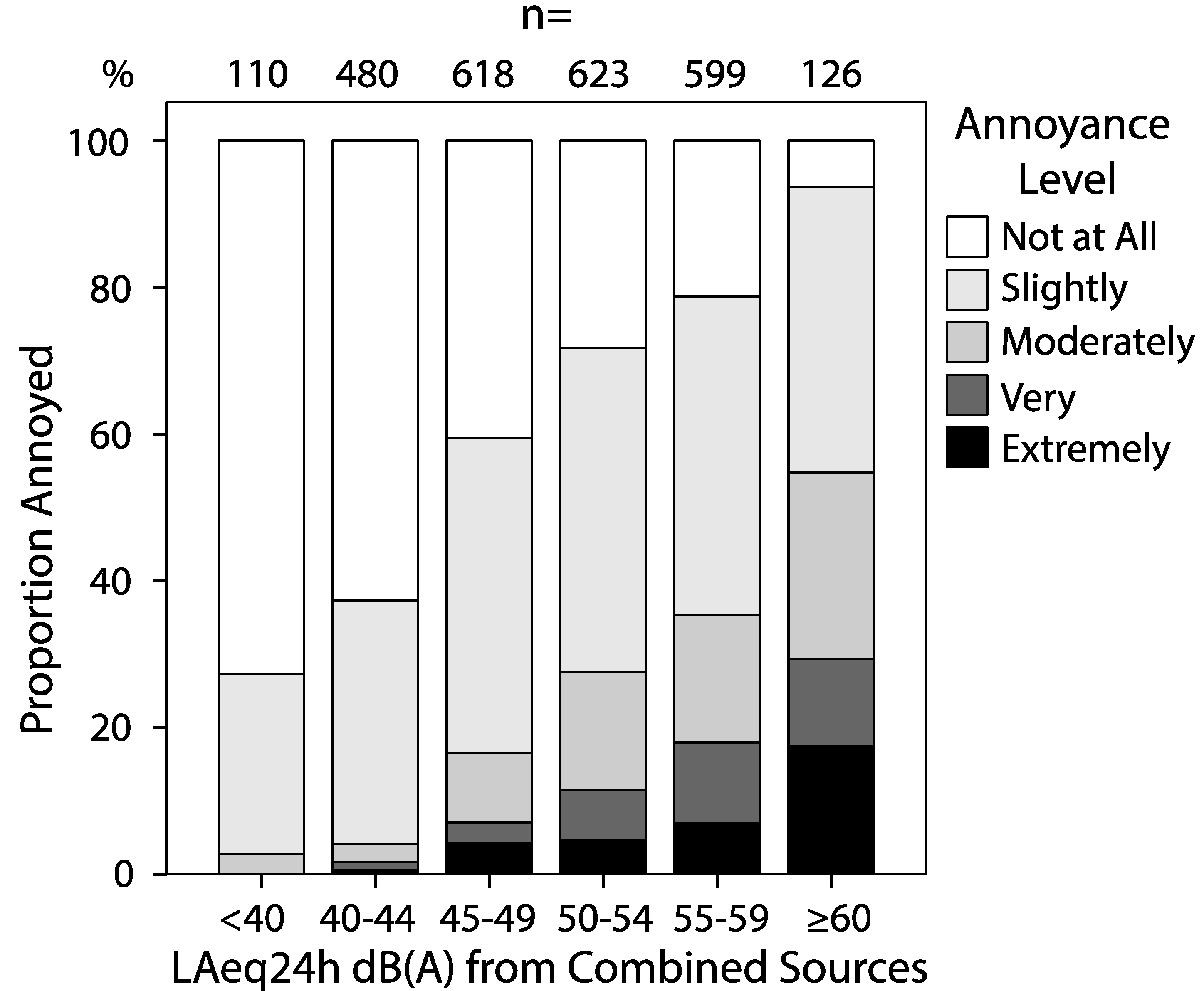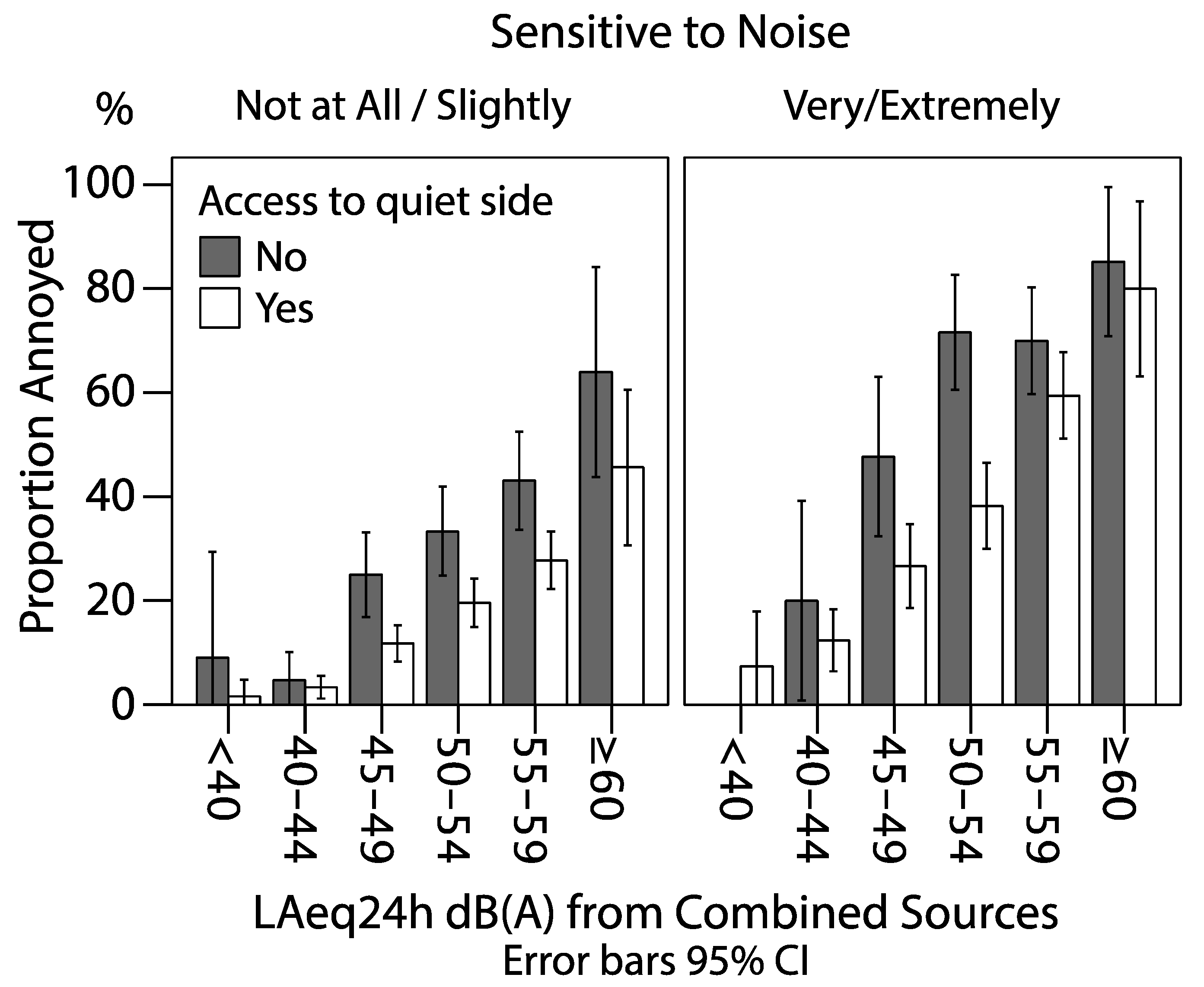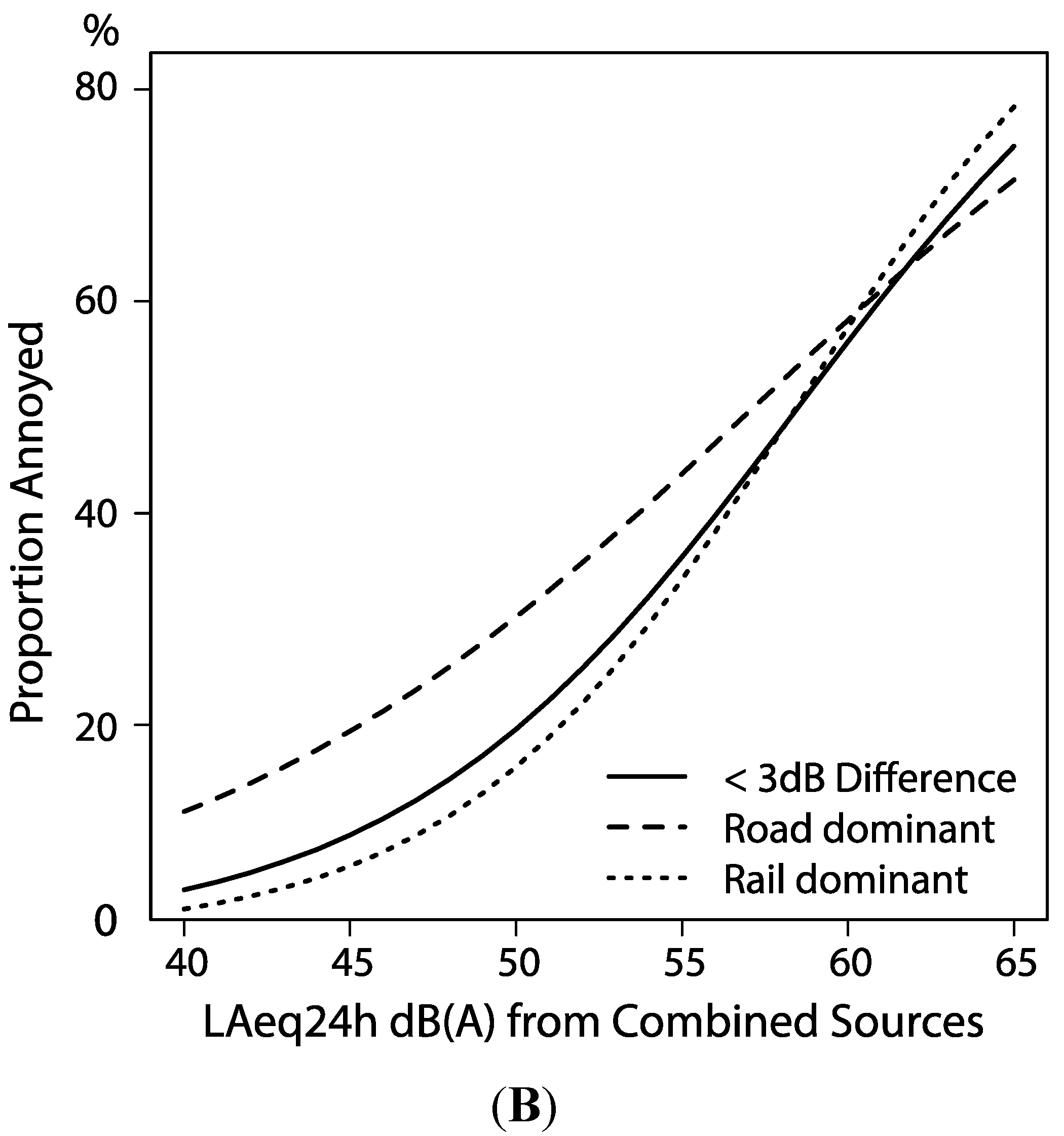Annoyance, Sleep and Concentration Problems due to Combined Traffic Noise and the Benefit of Quiet Side
Abstract
:1. Introduction
Aims and Hypothesis
2. Materials and Methods
2.1. Exposure Assessment
2.2. Study Population
2.3. Assessment of Adverse Effects
2.4. Assessment of Quiet Side
2.5. Statistical Analysis
| Non-Responders | Responders | Response Rate | ||
|---|---|---|---|---|
| n | n | % | ||
| Total | 2188 | 2612 | 54% | |
| Sex | ||||
| Women | 979 (45%) | 1420 (54%) | 59% | |
| Men | 1209 (55%) | 1192 (46%) | 50% | |
| Age | ||||
| 18–29 | 736 (34%) | 484 (19%) | 40% | |
| 30–49 | 883 (40%) | 971 (37%) | 52% | |
| 50–64 | 387 (18%) | 694 (27%) | 64% | |
| 65–79 | 182 (8%) | 463 (18%) | 72% | |
| Railway LAeq24h dB(A) | ||||
| <40 | 913 (42%) | 1301 (50%) | 59% | |
| 40–44 | 313 (14%) | 351 (13%) | 53% | |
| 45–49 | 228 (10%) | 257 (10%) | 53% | |
| 50–54 | 530 (24%) | 456 (17%) | 46% | |
| ≥55 | 204 (9%) | 247 (9%) | 55% | |
| Road LAeq24h dB(A) | ||||
| <40 | 185 (9%) | 340 (13%) | 62% | |
| 40–44 | 318 (15%) | 500 (20%) | 61% | |
| 45–49 | 565 (27%) | 704 (28%) | 55% | |
| 50–54 | 658 (31%) | 651 (25%) | 50% | |
| ≥55 | 402 (19%) | 361 (14%) | 47% | |
3. Results and Discussion
3.1. Descriptive Results
| Total | <55 dB(A) | ≥55 dB(A) | ||
|---|---|---|---|---|
| Age | Median (q1–q4) | 46 (33–61) | 48 (35–61) | 45 (31–61) |
| BMI | Median (q1–q4) | 24.6 (22.2–27.5) | 24.6 (22.3–27.3) | 24.5 (22.1–27.7) |
| Education | 9 years or less | 22% (560) | 19% | 24% |
| High School | 34% (873) | 34% | 35% | |
| University | 44% (1134) | 48% | 42% | |
| Place of birth | Sweden | 75% (1917) | 81% | 68% |
| Other | 25% (657) | 19% | 32% | |
| Strained economy | Yes | 8% (215) | 94% | 89% |
| No | 92% (2340) | 6% | 11% | |
| Sex | Male | 46% (1192) | 45% | 46% |
| Female | 54% (1420) | 55% | 54% | |
| Civil status | Co-living | 67% (1723) | 75% | 60% |
| Single/divorced | 33% (835) | 25% | 40% | |
| Smokers | Yes, current | 25% (631) | 22% | 28% |
| No, former/never | 75% (1908) | 78% | 73% | |
| Hearing impaired | Yes | 19% (493) | 19% | 19% |
| No | 81% (2090) | 81% | 81% |
3.2. The Benefit of Access to a Quiet Side
| LAeq24h dB(A) Combined | |||||||
|---|---|---|---|---|---|---|---|
| <40 | 40–44 | 45–49 | 50–54 | 55–59 | ≥60 | Total | |
| Window(s) facing green space | 82% (89) | 82% (392) | 74% (454) | 69% (429) | 67% (398) | 58% (72) | 72% (1834) |
| Bedroom window facing green space | 74% (80) | 76% (360) | 63% (386) | 59% (360) | 51% (302) | 36% (45) | 61% (1533) |
| Subjective access to quiet indoor space | 88% (96) | 84% (401) | 64% (388) | 55% (340) | 46% (270) | 37% (46) | 61% (1541) |
| Total (n) per exposure category | 110 | 480 | 618 | 623 | 599 | 126 | 2556 |

| OR (95% CI) | OR (95% CI) | OR (95% CI) | |
|---|---|---|---|
| Noise Annoyance | Poor Sleep Quality | Concentration Problems | |
| Crude | |||
| LAeq24h Combined 5 dB(A) | 2.03 (1.86–2.22) | 1.26 (1.16–1.38) | 1.14 (1.05–1.23) |
| Adjusted | |||
| LAeq24h combined 5 dB(A) | 2.10 (1.91–2.30) | 1.20 (1.10–1.31) | 1.09 (1.01–1.19) |
| Male (vs. Female) | 0.79 (0.64–0.97) | 0.75 (0.60–0.94) | 0.62 (0.50–0.77) |
| Age | 0.98 (0.98–0.99) | 1.01 (1.00–1.02) | 0.99 (0.98–0.99) |
| BMI | 0.98 (0.96–1.01) | 1.03 (1.00–1.05) | 1.01 (0.98–1.03) |
| Current smoker (vs. former/never) | 0.86 (0.68–1.10) | 1.10 (0.86–1.41) | 1.05 (0.82–1.33) |
| Single/Divorced (vs. co-living/married) | 0.87 (0.70–1.08) | 1.13 (0.89–1.42) | 1.25 (1.00–1.56) |
| High school (vs. low) | 1.08 (0.79–1.48) | 0.96 (0.70–1.30) | 0.88 (0.64–1.20) |
| University (vs. low) | 1.73 (1.27–2.35) | 0.85 (0.62–1.15) | 1.03 (0.76–1.39) |
| Born outside Sweden | 1.10 (0.88–1.39) | 1.87 (1.48–2.37) | 1.15 (0.91–1.46) |
| Strained economy | 1.88 (1.33–2.66) | 3.04 (2.18–4.25) | 3.31 (2.39–4.59) |
| Hearing impairment | 1.19 (0.90–1.56) | 1.30 (0.98–1.71) | 1.69 (1.30–2.19) |
| Also adjusted for quiet side | |||
| LAeq24h combined 5 dB(A) | 2.06 (1.88–2.26) | 1.20 (1.09–1.30) | 1.08 (0.99–1.17) |
| Window(s) facing green space | 0.47 (0.38–0.59) | 0.86 (0.68–1.09) | 0.76 (0.61–0.95) |
| Bedroom facing green space | 0.37 (0.30–0.45) | 0.78 (0.64–1.00) | 0.77 (0.63–0.96) |


3.3. Noise Annoyance and Noise Sensitivity
3.4. Noise Annoyance Related to Road, Rail and Combined Sources


4. Discussion
4.1. Access to a Quiet Side
4.2. Noise from Combined vs. Dominant Source
4.3. Strengths and Weaknesses
4.4. Results in Relation to Other Studies
4.5. Relevance for Policy
5. Conclusions
Supplementary Files
Supplementary File 1Acknowledgments
Author Contributions
Conflicts of Interest
References
- Fritschi, L.; Brown, L.; Kim, R.; Schwela, D.; Kephalopoulos, S. Burden of Disease from Envionmental Noise: Quantification of Healthy Life Years Lost in Europe; World Health Organization, Regional Office for Europe: Copenhagen, Denmark, 2011. [Google Scholar]
- Transporternas Utveckling till 2020, in Swedish; National Institute for Communication Analysis (SIKA): Stockholm, Sweden, 2005; Volume 6.
- Selander, J.; Nilsson, M.E.; Bluhm, G.; Rosenlund, M.; Lindqvist, M.; Nise, G.; Pershagen, G. Long-term exposure to road traffic noise and myocardial infarction. Epidemiology 2009, 20, 272–279. [Google Scholar] [CrossRef] [PubMed]
- Babisch, W. Transportation noise and cardiovascular risk: Updated review and synthesis of epidemiological studies indicate that the evidence has increased. Noise Health 2006, 8, 1–29. [Google Scholar] [CrossRef] [PubMed]
- Sorensen, M.; Hvidberg, M.; Andersen, Z.J.; Nordsborg, R.B.; Lillelund, K.G.; Jakobsen, J.; Tjonneland, A.; Overvad, K.; Raaschou-Nielsen, O. Road traffic noise and stroke: A prospective cohort study. Eur. Heart J. 2011, 32, 737–744. [Google Scholar] [CrossRef] [PubMed]
- Sorensen, M.; Andersen, Z.J.; Nordsborg, R.B.; Becker, T.; Tjonneland, A.; Overvad, K.; Raaschou-Nielsen, O. Long-term exposure to road traffic noise and incident diabetes: A cohort study. Environ. Health Perspect. 2013, 121, 217–222. [Google Scholar] [PubMed]
- Van Kempen, E.; Babisch, W. The quantitative relationship between road traffic noise and hypertension: A meta-analysis. J. Hypertens. 2012, 30, 1075–1086. [Google Scholar] [CrossRef] [PubMed]
- Riethmuller, S.; Muller-Wenk, R.; Knoblauch, A.; Schoch, O.D. Monetary value of undisturbed sleep. Noise Health 2008, 10, 46–54. [Google Scholar] [CrossRef] [PubMed]
- Den Boer, E.; Schroten, A. Traffic Noise Reduction in Europe; CE Delft: Delft, The Netherlands, 2007; p. 21. [Google Scholar]
- Marks, A.; Griefahn, B. Associations between noise sensitivity and sleep, subjectively evaluated sleep quality, annoyance, and performance after exposure to nocturnal traffic noise. Noise Health 2007, 9, 1–7. [Google Scholar] [CrossRef] [PubMed]
- Ohrstrom, E. Sleep disturbances caused by road traffic noise—Studies in laboratory and field. Noise Health 2000, 2, 71–78. [Google Scholar] [PubMed]
- Ohrstrom, E.; Björkman, M. Effects of noise-disturbed sleep—A laboratory study on habituation and subjective noise sensitivity. J. Sound Vib. 1988, 122, 277–290. [Google Scholar] [CrossRef]
- Griefahn, B.; Brode, P.; Marks, A.; Basner, M. Autonomic arousals related to traffic noise during sleep. Sleep 2008, 31, 569–577. [Google Scholar] [PubMed]
- Integrated Noise Regulations to Facilitate Housing Construction (Samordnade Bullerregler för att Underlätta Bostadsbyggandet); Statens Offentliga Utredningar (SOU): Stockholm, Sweden, 2013. (In Swedish)
- Ohrstrom, E.; Skanberg, A.; Svensson, H.; Gidlof-Gunnarsson, A. Effects of road traffic noise and the benefit of access to quietness. J. Sound Vib. 2006, 295, 40–59. [Google Scholar] [CrossRef]
- Van Renterghem, T.; Botteldooren, D. Focused study on the quiet side effect in dwellings highly exposed to road traffic noise. Int. J. Environ. Res. Public Health 2012, 9, 4292–4310. [Google Scholar] [CrossRef] [PubMed] [Green Version]
- Miedema, H.M.; Vos, H. Associations between self-reported sleep disturbance and environmental noise based on reanalyses of pooled data from 24 studies. Behav. Sleep Med. 2007, 5, 1–20. [Google Scholar] [CrossRef] [PubMed]
- Ohrstrom, E.; Barregard, L.; Andersson, E.; Skanberg, A.; Svensson, H.; Angerheim, P. Annoyance due to single and combined sound exposure from railway and road traffic. J. Acoust. Soc. Am. 2007, 122, 2642–2652. [Google Scholar] [CrossRef] [PubMed]
- Lercher, P.; Brink, M.; Rüdisser, J.; Renterghem, T.V.; Botteldooren, D.; Baulac, M.; Defrance, J. The effects of railway noise on sleep medication intake: Results from the alpnap-study. Noise Health 2010, 12, 110–119. [Google Scholar] [CrossRef] [PubMed]
- Elmenhorst, E.-M.; Pennig, S.; Rolny, V.; Quehl, J.; Mueller, U.; Maaß, H.; Basner, M. Examining nocturnal railway noise and aircraft noise in the field: Sleep, psychomotor performance, and annoyance. Sci. Total Environ. 2012, 424, 48–56. [Google Scholar] [CrossRef] [PubMed]
- Directive 2002/49/EC of the european parliament and of the council of 25 June 2002 relating to the assessment and management of environmental noise. In 2002/49/EC; European Parliament, Council of the European Union: Bruselles, Belgium, 2002.
- Malmö Stad Strategisk Bullerkartläggning; Ingemansson: Malmö, Sweden, 2007. (In Swedish)
- Bendtsen, H. The nordic prediction method for road traffic noise. Sci. Total Environ. 1999, 235, 331–338. [Google Scholar] [CrossRef]
- Road traffic noise: Nordic prediction method. In TemaNord, 1996:525, 1st ed.; Nordic Council of Ministers (Nordiska ministerrådet): Copenhagen, Denmark, 1996; p. 74.
- Naturvårdverket. Buller Från Spårburen Trafik: Nordisk Beräkningsmodell; Naturvårdsverket: Stockholm, Sweden, 1999. [Google Scholar]
- Ohrstrom, E.; Barregård, L. Undersökning av Hälsoeffekter av Buller Från Vägtrafik, tåg och flyg i Lerums Kommun; Västra Götalandsregionens Miljömedicinska Centrum, Sahlgrenska Akademin vid Göteborgs Universitet, Avd. för Miljömedicin: Göteborg, Sweden, 2005; p. 120. (In Swedish) [Google Scholar]
- ISO. ISO/TS 15666 Technical Specification, Acoustics—Assessment of Noise Annoyance by Means of Social and Socio-Acoustic Surveys; International Organization for Standardization: Geneva, Switzerland, 2003. [Google Scholar]
- Berglund, B.; Lindvall, T.; Schwela, D.H. Guidelines for Community Noise; World Health Organisation: Geneva, Switzerland, 2000. [Google Scholar]
- Miedema, H.M.; Oudshoorn, C.G. Annoyance from transportation noise: Relationships with exposure metrics DNL and DENL and their confidence intervals. Environ. Health Perspect. 2001, 109, 409–416. [Google Scholar] [CrossRef] [PubMed]
- Skanberg, A.; Ohrstrom, E. Sleep disturbances from road traffic noise: A comparison between laboratory and field settings. J. Sound Vib. 2006, 290, 3–16. [Google Scholar] [CrossRef]
- Bodin, T.; Bjork, J.; Ohrstrom, E.; Ardo, J.; Albin, M. Survey context and question wording affects self reported annoyance due to road traffic noise: A comparison between two cross-sectional studies. Environ. Health 2012. [Google Scholar] [CrossRef]
- Young, T.; Palta, M.; Dempsey, J.; Skatrud, J.; Weber, S.; Badr, S. The occurrence of sleep-disordered breathing among middle-aged adults. N. Engl. J. Med. 1993, 328, 1230–1235. [Google Scholar] [CrossRef] [PubMed]
- Wetter, D.W.; Young, T.B.; Bidwell, T.R.; Badr, M.S.; Palta, M. Smoking as a risk factor for sleep-disordered breathing. Arch. Intern. Med. 1994, 154, 2219–2224. [Google Scholar] [CrossRef] [PubMed]
- Partinen, M.; Gislason, T. Basic nordic sleep questionnaire (BNSQ): A quantitated measure of subjective sleep complaints. J. Sleep Res. 1995, 4, 150–155. [Google Scholar] [CrossRef]
- Montgomery, S.A.; Asberg, M. A new depression scale designed to be sensitive to change. Brit. J. Psychiatr. 1979, 134, 382–389. [Google Scholar] [CrossRef]
- Goldberg, D.; Williams, P. General Health Questionnaire (GHQ); NFER-Nelson: Swindon, Wiltshire, UK, 2000. [Google Scholar]
- Basner, M.; Babisch, W.; Davis, A.; Brink, M.; Clark, C.; Janssen, S.; Stansfeld, S. Auditory and non-auditory effects of noise on health. Lancet 2014, 383, 1325–1332. [Google Scholar] [CrossRef] [PubMed]
- Miedema, H.M. Relationship between exposure to multiple noise sources and noise annoyance. J. Acoust. Soc. Am. 2004, 116, 949–957. [Google Scholar] [CrossRef] [PubMed]
- De Kluizenaar, Y.; Janssen, S.A.; Vos, H.; Salomons, E.M.; Zhou, H.; van den Berg, F. Road traffic noise and annoyance: A quantification of the effect of quiet side exposure at dwellings. Int. J. Environ. Res. Public Health 2013, 10, 2258–2270. [Google Scholar] [CrossRef] [PubMed]
- De Kluizenaar, Y.; Salomons, E.M.; Janssen, S.A.; van Lenthe, F.J.; Vos, H.; Zhou, H.; Miedema, H.M.; Mackenbach, J.P. Urban road traffic noise and annoyance: The effect of a quiet facade. J. Acoust. Soc. Am. 2011, 130, 1936–1942. [Google Scholar] [CrossRef] [PubMed]
© 2015 by the authors; licensee MDPI, Basel, Switzerland. This article is an open access article distributed under the terms and conditions of the Creative Commons Attribution license (http://creativecommons.org/licenses/by/4.0/).
Share and Cite
Bodin, T.; Björk, J.; Ardö, J.; Albin, M. Annoyance, Sleep and Concentration Problems due to Combined Traffic Noise and the Benefit of Quiet Side. Int. J. Environ. Res. Public Health 2015, 12, 1612-1628. https://doi.org/10.3390/ijerph120201612
Bodin T, Björk J, Ardö J, Albin M. Annoyance, Sleep and Concentration Problems due to Combined Traffic Noise and the Benefit of Quiet Side. International Journal of Environmental Research and Public Health. 2015; 12(2):1612-1628. https://doi.org/10.3390/ijerph120201612
Chicago/Turabian StyleBodin, Theo, Jonas Björk, Jonas Ardö, and Maria Albin. 2015. "Annoyance, Sleep and Concentration Problems due to Combined Traffic Noise and the Benefit of Quiet Side" International Journal of Environmental Research and Public Health 12, no. 2: 1612-1628. https://doi.org/10.3390/ijerph120201612







